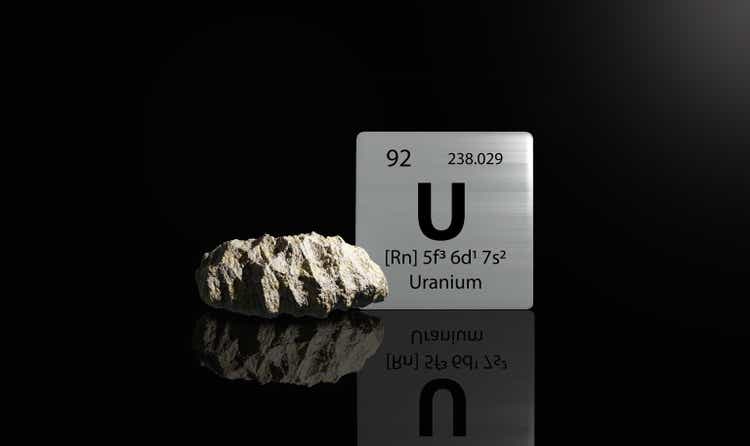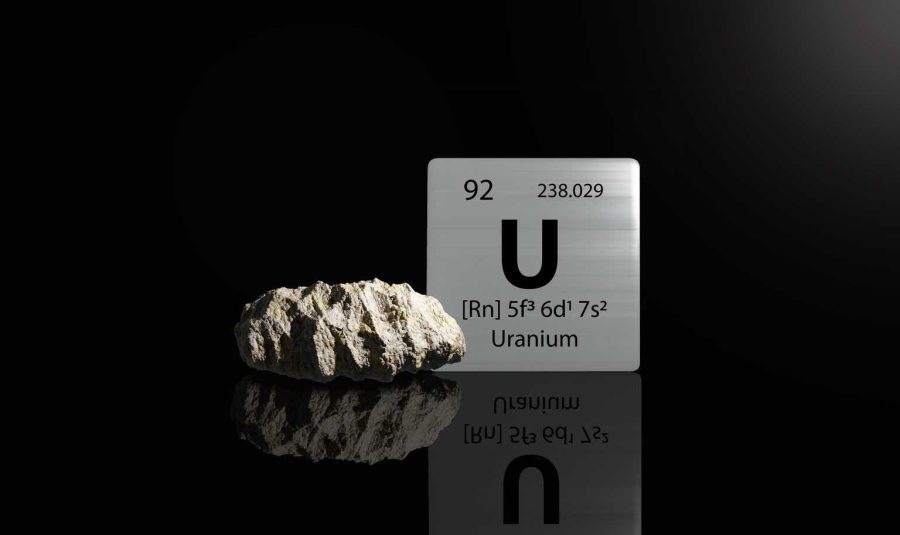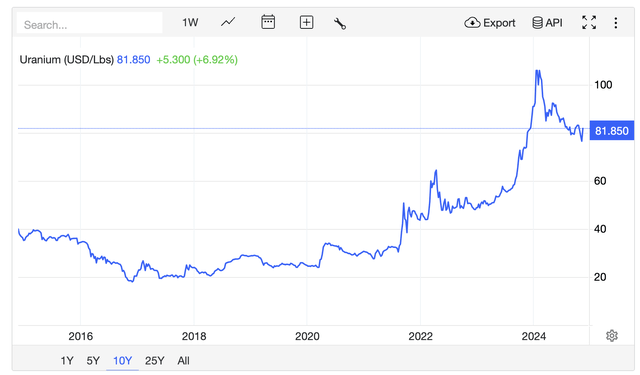Summary:
- Denison Mines Corp.’s financial position is robust, with C$106m in cash, C$243m in uranium investments, and no debt, ensuring operational funding until production starts.
- The company’s premier project, Wheeler River’s Phoenix site, targets production by 2027-2028 using cost-effective and environmentally friendly ISR mining techniques.
- The outlook for nuclear energy is promising, with increasing demand from governments and tech giants like Amazon and Alphabet, boosting uranium’s long-term prospects.
- I am closely monitoring Denison Mines, expecting substantial rewards from its projects and considering it a significant investment opportunity despite potential short-term uranium price fluctuations.
Ole_CNX
Introduction
Denison Mines Corp. (NYSE:DNN) recently reported its Q3 results, so I wanted to go through the company’s operational progress and what is out there for the future potential. DNN’s financial position is outstanding, which will continue to help fund its operations until meaningful production begins to bear fruit in the upcoming years. Its strategic positioning and overall projected demand increase in nuclear energy should make the company very profitable.
By The Numbers
The company’s top line came in at C$700k, -35.8% y/y, while its GAAP loss came in at -C$0.03. For the nine months ended September 30th, ’24, the company’s total revenues came in at around $2.85m.
The company’s financial position shows that DNN has around C$106m in cash and equivalents and C$243m in physical investments in uranium. To accompany this great liquidity position, the company has no debt on its books. The company is flush with cash, which means it has plenty of time to get through the pre-production stages until the projects start to yield the product in the future. So, until then, it is expected that the company will continue to run at a loss consistently. That is, unless it decides to continue to fund its operations through the sale of its physical uranium (UXA:COM), which it did last year. The company sold some of its uranium for a C$68m gain, which brought the company into profitable territory. This year, it appears that the company sold some uranium for a loss of around -C$15m. DNN sold 100,000 pounds of uranium for proceeds of C$13,598,000, or US$10M.
Nothing exciting out of these quarterly results, since the company isn’t making much out of production yet and mostly makes its revenues from toll milling and other activities related to exploration, evaluation, and development. That will come once the projects start production.
Comments on the Outlook
The company is quite shareholder-friendly, in my opinion. Denison provides a monthly update on the progress of its operations. There is not much that changes m/m, but it is nice to see the progress.
Let’s look at the company’s main project, which the company holds a 95% interest in, the Wheeler River project. Within the project, the company’s premier development site, the Phoenix, which will be an ISR operation with on-site processing, will have around 16.5 years of mining life. The company has been taking all the necessary actions to get the site up and running by getting all the permits, environmental impact statements, de-risking programs, and feasibility tests a couple of years back. It has a timeline of 2 years of construction to take place, which means the first production is targeted to be for 2027 or 2028, depending on how well these plans go.
This site is considered one of the largest undeveloped uranium mining projects around the world and contains high-grade uranium deposits. DNN is going to use the ISR mining technique (In-Situ Recovery), which should please environmentalists because this technique involves injecting a leaching solution into the ground to dissolve the ore and pump it back up for recovery. This is an environmental advantage because it doesn’t require a lot of disturbance of the surrounding earth’s surface and reduces the need for large-scale infrastructure. This method is also very cost-effective and one of the lowest-cost methods out there currently. All the company has to do now is to continue its ambitious plan of getting it into the operation stage, extracting the uranium, and generating substantial top-line and cash flows.
After the company begins full production at the Phoenix site, the next project on the list is the Gryphon site. This project is expected to be funded by the proceeds of the Phoenix site.
The company also has some interest in other mines and uranium mills at much lower interest, for example, 22.5% in McClean Lake Uranium Mills & Mines. This site is currently processing ore from the Cigar Lake Mine, with mining restart approved and begin operations once more next year of around 800,000 lbs. of uranium.
Denison also has around 70% interest in the Waterbury Lake Project, which will employ the same ISR mining technique as in the Phoenix. It is not a particularly massive development, with an estimated 6 years of mining life, however, once it is fully in production, the company expects around 77% in operating profits. The company also has a vested interest in other strategic development-stage assets, which should help the company eventually.
Investor Slides
So, it looks to me like the company is getting much closer to beginning its production stage of the cycle already. The company’s timeline of operations is very promising, and I expect DNN to reap massive rewards once operations get going. The company has plenty of different projects, and most of them will start to reward everyone in the upcoming years. The company’s projections show fantastic profit margins, which may vary depending on the prices of uranium, of course. Over the last few years, uranium prices skyrocketed and even passed $100/lb. Since the end of FY23, prices have come down slightly, but are still very much elevated from the price it saw just back in 2020.
Recently, the Biden Administration announced that it plans to triple nuclear energy capacity by 2050, which coincides with DNN’s outlook for the sector, as it expects more than 20 nations to triple nuclear energy capacity by 2050. That is, of course, excellent news for the company. There will not be a shortage of demand, but that doesn’t apply to supply, which can affect uranium prices dramatically.
Not only the governments are looking to nuclear, but also mega tech companies like Amazon (AMZN), which recently announced that it is looking to enter the race for nuclear energy to power its AI operations going forward. Alphabet (GOOG) (GOOGL) is also buying up nuclear power for the same reason, as AMZN recently announced that it will be buying energy from a fleet of mini reactors from California’s Kairos Power. I am sure this is just the beginning as AI becomes more powerful and power-hungry. Other players will follow suit. Meta Platforms (META) recently faced some complications with its nuclear power plant due to a rare species of bees on location. I doubt that is going to stop it from looking somewhere else. META is not going to fall behind the other cloud and AI players.
In Conclusion
I think there will be a giant opportunity for investors in the coming years, and I will be monitoring the situation going forward. This relies upon the next government taking place in the US and how the demand for nuclear energy progresses over the coming quarters.
I am also going to look at the company in a lot more detail by following the investor updates for a while. I would like to see if there will be more updates on the progress of all the projects in the future. For now, I am putting the company on my main watch list, as it is getting rather interesting.
Uranium prices may come down over the next while even more since the price does seem rather high, but that is only speculation on my end.
Analyst’s Disclosure: I/we have no stock, option or similar derivative position in any of the companies mentioned, and no plans to initiate any such positions within the next 72 hours. I wrote this article myself, and it expresses my own opinions. I am not receiving compensation for it (other than from Seeking Alpha). I have no business relationship with any company whose stock is mentioned in this article.
Seeking Alpha’s Disclosure: Past performance is no guarantee of future results. No recommendation or advice is being given as to whether any investment is suitable for a particular investor. Any views or opinions expressed above may not reflect those of Seeking Alpha as a whole. Seeking Alpha is not a licensed securities dealer, broker or US investment adviser or investment bank. Our analysts are third party authors that include both professional investors and individual investors who may not be licensed or certified by any institute or regulatory body.

